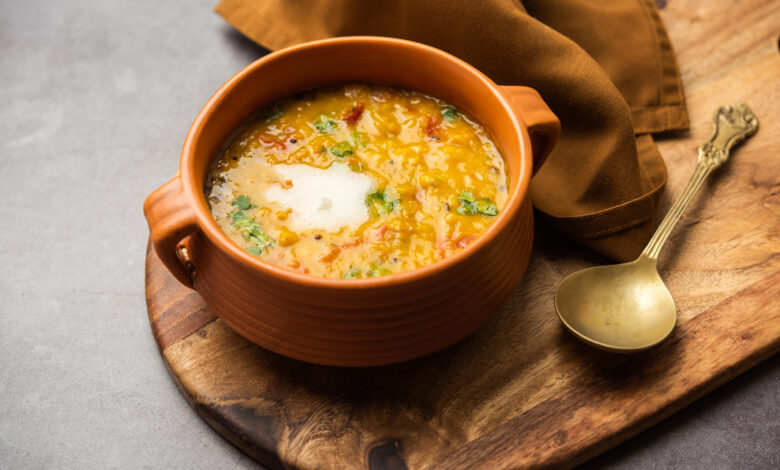Is Dal Good for Weight Loss? Let’s Find Out

Dal, a type of dried split pea or lentil, is a staple dish in India that people commonly eat with hot cooked rice or roti. Different types of dal are popular in various regions of India, depending on what is locally available. For example, pigeon peas (Toor dal) and mung beans (Moong dal) are widely used in the south, while yellow split peas or chana dal are popular in the north.
While every type of dal has its distinct colour and size, all of them share one common trait – their high protein and fibre content make them an excellent choice for weight loss. Eating dal can help to control your calorie intake and promote weight loss due to its high satiety value
Types of Dal
In Indian culture, dal refers to any split or whole pulse. It is also known as Indian lentils. Dal is both a dish and an ingredient, depending on your use. Dal is the best-known vegan and vegetarian protein naturally available today. Research shows that 30% of dal’s calories are from protein, making dal one of the five healthiest food groups.
There are over 50 different dal groups in India. Here are five basic dals to get you started:
Chana Dal
Chana dal, or chickpea, is primarily known for its protein content and nutty flavour. It is an integral part of the DASH diet, most likely due to its magnesium and potassium content. Chana dal, including canned varieties, has a glycemic index value between 28 and 40. Therefore, it is also suitable for people with diabetes.
Masoor Dal
Masoor dal is one of the most common types of lentils. These whole or split red lentils take the least time to cook. Masoor dal is superior in providing B vitamins, particularly vitamin B9 or folate.
Moong (Mung) Dal
Moong dal is available in green and yellow varieties. Sprouted moong dal is a nutritional powerhouse. It is the most common mid-meal snack in almost all weight loss diets. Consuming sprouted moong dal or green gram is a great way to prevent unwanted hunger pangs.
Toor Dal (Split Pigeon Peas)
Toor dal or Arhar dal contains three essential amino acids. They are methionine, lysine and tryptophan. You can also use toor dal instead of soya bean to make tempeh or tofu. They are good additions to a vegan weight loss diet. In contrast to the mature toor dal, immature ones have a slightly higher fat content.
Urad Dal
Urad dal is particularly popular in the South Indian region. This lentil is suitable for making fermented foods like dosa, idli, or vada. For weight loss, urad dal khichdi is the best dinner option. The dish has a high satiety value that prevents late-night snacking.
Dal for Weight Loss: An Overview
Dal, also known as dahl or dhal, is a popular dish in many parts of India and South Asia. It is made using lentils and a mixture of spices, sometimes with additional ingredients such as vegetables or meat. As a source of protein and fibre, dal can be a beneficial food for weight loss as it can help you feel full and satisfied, reducing the need for overeating and snacking on high-calorie foods. Additionally, lentils are low in calories and fat, making them ideal for weight loss.
The calorie content of dal can depend on its preparation. For example, adding fats like ghee or oil or high-calorie ingredients such as coconut milk or cream can increase the calorie content. To keep the calorie content low, use minimal oil and avoid adding high-calorie ingredients. It’s important to remember that weight loss is a complex process that depends on various factors, including diet, exercise, and genetics. Therefore, while dal can be part of a weight loss plan, one should combine it with other healthy habits to achieve optimal results.
Is Dal Good for Weight Loss?
No foods, including dal, can burn fat and make you lose weight. Nevertheless, dal is a nutritious food you can add to any weight loss eating plan. Weight loss happens by making a calorie deficit. It means you burn more calories than you take in every day. You can create a calorie deficit by replacing high-calorie foods with low-calorie options. For example, dal is a filling replacement for high-calorie, high-fat foods.
A study shows that women who ate chana dal instead of white bread consumed fewer calories at their next meal. The findings conclude that chana dal helps in body weight management by suppressing appetite. So you become less hungry at your next meal. Consequently, you eat fewer calories.
Other Benefits of Dal for Weight Loss
Low in Net Carbs
Many people trying to lose weight avoid legumes like lentils thinking they are high in carbohydrates. However, you can still enjoy dal on a low-carbohydrate diet. Most of the carbohydrates in dal come from fibre, which your body does not absorb. Furthermore, only 10% of the calories come from simple sugars.
According to USDA, 1 cup of dal contains 46 grams of carbohydrates and 18 grams of fibre. However, 18 of the 46 g of carbohydrates are fibre and do not get digested. Therefore, the net carbs are only around 28 g. It is even less when the serving size is half a cup.
Rich in Fibre
Glucose levels that fluctuate widely can lead to higher insulin levels. Over time, this can result in insulin resistance. Studies show that insulin resistance can cause your body to store more fat. However, high-fibre foods like dal help keep blood sugar levels more stable.
Another study notes that the flavonoids and fibre in dal enhance satiety and lower the amount of food intake. It leads to maintaining body weight in obese subjects. Besides that, polyphenol-rich lentils control postprandial glucose in obese diabetic patients.
Rich in Protein
According to USDA, 1 cup of dal contains nearly 20 g of protein. As a result, it helps maintain lean mass while you lose weight.
Protein also has a much higher thermic effect than carbs and fat. It means that your body burns more calories digesting and metabolising protein. According to one study, the thermic effect of protein is around 20-30%, compared to carbs (5-10%) and fat (0-3%).
Which Dal is Good for Weight Loss?
There is much debate surrounding which dal is good for weight loss. So, is moong dal good for weight loss? Or is chana dal good for weight loss? All you need to do is to choose a dal high in protein and fibre. At the same time, you should monitor the serving size, too.
Here is the protein and fibre in 100 grams of different dal varieties:
- Raw moong dal (split mung beans): 23.9 g protein and 16.3 g fibre (As per USDA)
- Raw chana dal (chickpeas): 20.5 g protein and 12.2 g fibre (As per USDA)
- Urad dal (Vigna mungo): 25.2 g protein and 18.3 g fibre (As per USDA)
- Toor dal: 21.7 g protein and 15 g fibre (As per USDA)
- Masoor dal: 24.4 g protein and 11.1 g fibre (As per USDA)
The HealthifyMe Note
Various varieties of dal can help with weight loss due to their high protein and fibre content. However, it is essential to monitor portion size. Some good options include chana dal, moong dal, urad dal, and toor dal.
Things to be Mindful About When Consuming Dal
Dal, in moderate amounts, is safe and does not cause any concerning side effects. However, you also need to prepare them in the right way. Raw or undercooked dal can cause food poisoning, diarrhoea, and vomiting. Also, since dal belongs to the same family as beans, you should be cautious if you are allergic to legumes.
Although you need fibre in your diet, overeating can cause digestive discomfort. Hence, overeating dal leads to gas, bloating, flatulence, and indigestion.
Dal also changes its calorie density depending on how you cook it. For example, boiling dal will have lower calorie density because of water absorption. However, reheating dal in cooking oil or adding lots of ghee can change the net calories. So, when on a weight loss diet, check the recipes.
Before making any significant dietary changes, it is always a good idea to check with your doctor first. This way, you can avoid any potential adverse side effects. HealthifyMe nutritionists can advise how to best incorporate dal into your diet for maximum benefit, including weight loss. You can also receive suggestions on healthier dal recipe options.
Conclusion
Though the ingredients and preparation methods vary, dal is generally considered a healthy food due to its high protein and fibre content. In addition, due to its high-satiating nature, dal is a weight-loss-friendly food that can help curb calorie intake.
Dal recipes vary from household to household. While some people might cook their dal with lots of oil and butter, others might use minimal amounts or none at all. It is essential to consider how you cook your dal, as this can alter the caloric content. Whether you are watching your calories for weight loss or want to make a healthier version of dal, HealthifyMe nutritionists can help you find the right approach.
Frequently Asked Questions (FAQs)
Q. Can you lose weight eating dal?
A. No single food in isolation will make you lose or gain weight. However, dal is a low-calorie food with high fibre and protein. Therefore, it can keep you satiated for an extended period and help create a calorie deficit. This calorie deficit ultimately helps with weight loss.
Q. Does dal reduce belly fat?
A. The thermic effect of protein in dal makes it a superfood for reducing belly fat. In addition, Moong dal is rich in fibre and plant-based protein, which can be very useful for weight loss. Besides moong dal, eating masoor dal improves digestion. A well-functioning digestive system utilises calories and aids in belly fat or overall weight loss.
Q. Can dal increase weight?
A. Consuming the recommended amounts of dal does not cause weight gain. Instead, their fibre and protein content are ideal for losing weight. Dal gives you the right amount of nutrition without piling on the calories. However, overconsumption can have side effects.
Q. Can I eat moong dal daily for weight loss?
A. You can include moong dal in your daily diet for weight loss. It encourages weight loss by making you feel full after a meal and preventing overeating. However, people with digestive issues should not eat fibre-rich dal daily. Heavy dal, like chana and urad dal, is gas-forming. There are light, easy-to-digest varieties of dal, like moong dal.
Q. Which dal is high in protein?
A. Moong dal is one of the best plant-based sources of protein. It is low in fat content and very high in protein. One hundred grams of moong dal contains nearly 23 g of protein. Yellow split moong dal provides 25.5 g of protein per 100 g serving. Urad dal also provides a similar amount of protein as yellow moong dal. Other types of dal also offer a decent amount of protein. For example, 100 g of chana dal has 20.5 g of protein.
Q. Which dal is high in calories?
A. Chana dal and masoor dal are the highest in calories. One hundred grams of chana dal has 378 calories. The exact amount of masoor dal contains around 356 calories. Keep in mind that the calories can vary significantly based on preparation. For instance, half a cup of moong dal contains 120 calories. This calorie count is bound to rise if you prepare dal with a generous amount of ghee, oil and other ingredients.
The Supporting Sources
1. Singh, K. & Singh, Anil. (2014). Lentil in India: An Overview. 10.13140/2.1.2191.1049.
https://www.researchgate.net/publication/266968749_Lentil_in_India_An_Overview
2. Zafar, T. A., & Kabir, Y. (2017). Chickpeas suppress postprandial blood glucose concentration and appetite and reduce energy intake at the next meal. Journal of food science and technology, 54(4), 987–994.
https://pubmed.ncbi.nlm.nih.gov/28303049/
3. Data by the US Department of Agriculture. Data Type: Survey | Food Category: Beans, peas, legumes | FDC ID: 2342902 | Food Code: 41305050
https://fdc.nal.usda.gov/fdc-app.html#/food-details/2342902/nutrients
4. Verkouter, I., Noordam, R., le Cessie, S., van Dam, R. M., Lamb, H. J., Rosendaal, F. R., van Heemst, D., & de Mutsert, R. (2019). The Association between Adult Weight Gain and Insulin Resistance at Middle Age: Mediation by Visceral Fat and Liver Fat. Journal of clinical medicine, 8(10), 1559.
https://www.ncbi.nlm.nih.gov/pmc/articles/PMC6832997/
5. Ganesan, K., & Xu, B. (2017). Polyphenol-Rich Lentils and Their Health Promoting Effects. International journal of molecular sciences, 18(11), 2390.
https://www.ncbi.nlm.nih.gov/pmc/articles/PMC5713359/
6. Westerterp K. R. (2004). Diet-induced thermogenesis. Nutrition & metabolism, 1(1), 5.
https://www.ncbi.nlm.nih.gov/pmc/articles/PMC524030/
7. Data by the US Department of Agriculture. Data Type: SR Legacy | Food Category: Legumes and legume products | FDC ID: 174256
https://fdc.nal.usda.gov/fdc-app.html#/food-details/174256/nutrients
8. Data by the US Department of Agriculture. Data Type: SR Legacy | Food Category: Legumes and legume products | FDC ID: 173756
https://fdc.nal.usda.gov/fdc-app.html#/food-details/173756/nutrients
9. Data by the US Department of Agriculture. Data Type: SR Legacy | Food Category: Legumes and legume products | FDC ID: 174259
https://fdc.nal.usda.gov/fdc-app.html#/food-details/174259/nutrients
10. Data by the US Department of Agriculture. Data Type: SR Legacy | Food Category: Legumes and legume products | FDC ID: 172436
https://fdc.nal.usda.gov/fdc-app.html#/food-details/172436/nutrients
11. Data by the US Department of Agriculture. Data Type: Branded | Food Category: Vegetable and lentil mixes | FDC ID: 1580041
https://fdc.nal.usda.gov/fdc-app.html#/food-details/1580041/nutrients




